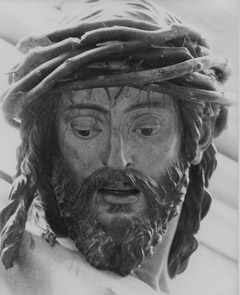
Juan Martínez Montañés
Encyclopedia

Juan Martínez Montañés (March 16, 1568 – June 18, 1649), known as el Dios de la Madera (the God of Wood), was a Spanish sculptor
Sculpture
Sculpture is three-dimensional artwork created by shaping or combining hard materials—typically stone such as marble—or metal, glass, or wood. Softer materials can also be used, such as clay, textiles, plastics, polymers and softer metals...
, born at Alcalá la Real
Alcalá la Real
Alcalá la Real is a city located in the province of Jaén, Spain. According to the 2006 census , the city has a population of 22,129 inhabitants.-Geography:...
, in the province of Jaén. He was one of the most important figures of the Sevillian school of sculpture
Sevillian school of sculpture
The Sevillian school of sculpture—the tradition of Christian religious sculpture in Seville, Andalusia, Spain—began in the 13th century, formed a clear tradition of its own in the 16th century, and continues into the present....
.
His master was Pablo de Roxas. His first known work, dating 1597, is the graceful St. Christopher in the church of El Salvador at Seville
Seville
Seville is the artistic, historic, cultural, and financial capital of southern Spain. It is the capital of the autonomous community of Andalusia and of the province of Seville. It is situated on the plain of the River Guadalquivir, with an average elevation of above sea level...
. His Boy Christ (dated 1607) is in the sacristy
Sacristy
A sacristy is a room for keeping vestments and other church furnishings, sacred vessels, and parish records.The sacristy is usually located inside the church, but in some cases it is an annex or separate building...
of the cathedral of Seville. His masterpiece, the great altar of St Jerome at San Isidoro del Campo, Santiponce
Santiponce
Santiponce is a city located in the province of Seville, Spain. According to the 2006 census , the city has a population of 7742 inhabitants.The city contains the ruins of Roman city Italica.-External links:...
, near Seville, was contracted in 1609 and completed in 1613. Montañés executed most of his sculpture in wood, which was gessoed, polychromed and gilded.
Other works were the great altars at Santa Clara in Seville and at San Miguel in Jerez, the Conception
Conception
Conception, or a concept, is an abstract idea or a mental symbol.Conception may also refer to:* Conception, or fertilisation, the fusion of gametes to produce a new organism.* Conception , an album by Miles Davis...
and the realistic figure of Christ Crucified in Cristo de la Clemencìa, commissioned in 1603, in the sacristy of Seville cathedral (illustration); the figure of St John the Baptist, and the St Bruno
Bruno of Cologne
Saint Bruno of Cologne , the founder of the Carthusian Order, personally founded the order's first two communities...
(1620); a tomb for Don Pérez de Guzmán and his wife (1619); the highly realistic polychromed wood head and hands of St Ignatius of Loyola (1610) and of St Francis Xavier in the university church of Seville, where the costumed figures were used in celebrations.
Montañés achieved great fame in his lifetime; he died in 1649, leaving a large family. His works are more realistic than imaginative, but this, allied with an impeccable taste, produced remarkable results. In 1635, in preparation for the bronze equestrian statue of King Philip IV
Philip IV of Spain
Philip IV was King of Spain between 1621 and 1665, sovereign of the Spanish Netherlands, and King of Portugal until 1640...
by Pietro Tacca
Pietro Tacca
Pietro Tacca was an Italian sculptor, who was the chief pupil and follower of Giambologna. Tacca began in a Mannerist style and worked in the Baroque style during his maturity.-Biography:...
, Montañés went to Madrid
Madrid
Madrid is the capital and largest city of Spain. The population of the city is roughly 3.3 million and the entire population of the Madrid metropolitan area is calculated to be 6.271 million. It is the third largest city in the European Union, after London and Berlin, and its metropolitan...
and spent seven months there modelling a portrait of Philip IV. The work was sent to Tacca in Florence as primary reference for the King, and the statue was finished in 1640. During his stay in Madrid he had his portrait
Portrait of Juan Martínez Montañés
The Portrait of Juan Martínez Montañés is an unfinished 1636 portrait of the sculptor Juan Martínez Montañés by Diego Velázquez. It is now at the Prado. It was painted while its subject called on Velazquez during a trip to Madrid between June 1635 and January 1636...
painted by Diego Velázquez
Diego Velázquez
Diego Rodríguez de Silva y Velázquez was a Spanish painter who was the leading artist in the court of King Philip IV. He was an individualistic artist of the contemporary Baroque period, important as a portrait artist...
, whose tutor had worked for him.
He had many imitators, his son Alonzo Martínez, who died in 1668, being among them. His students included Juan de Mesa
Juan de Mesa
Juan de Mesa y Velasco was a Spanish Baroque sculptor. He was the creator of several of the effigies that are used in the procession during the Holy Week in Seville....
.

